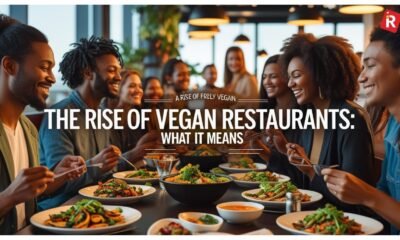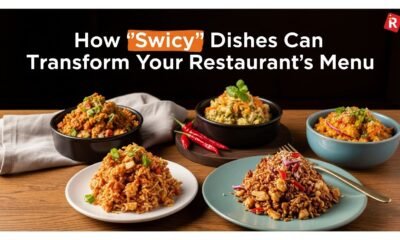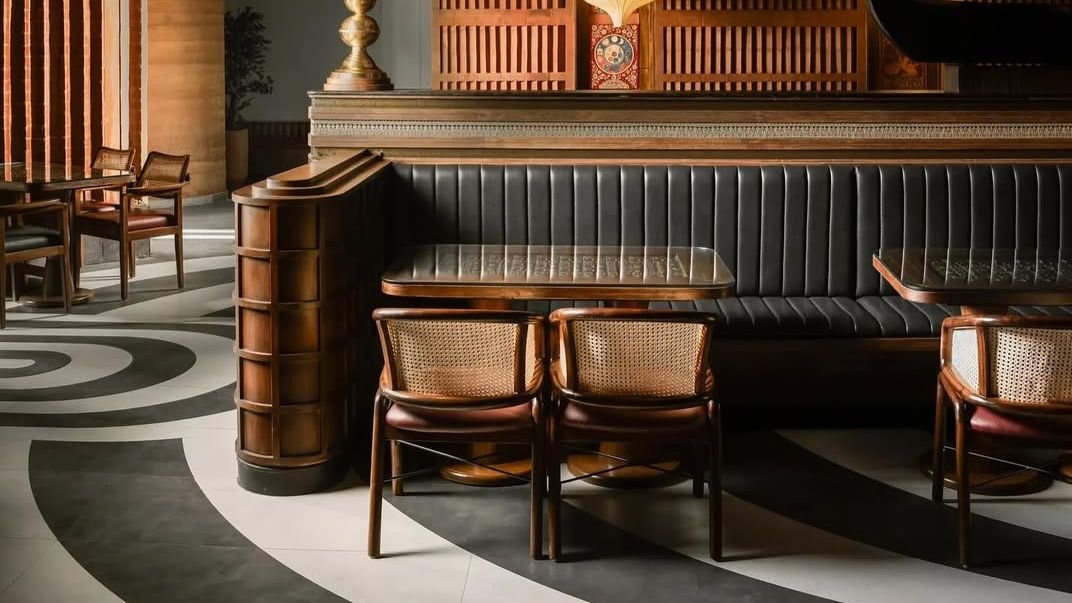Restaurants & Food
10 Best Instagram Marketing Strategies for Restaurants
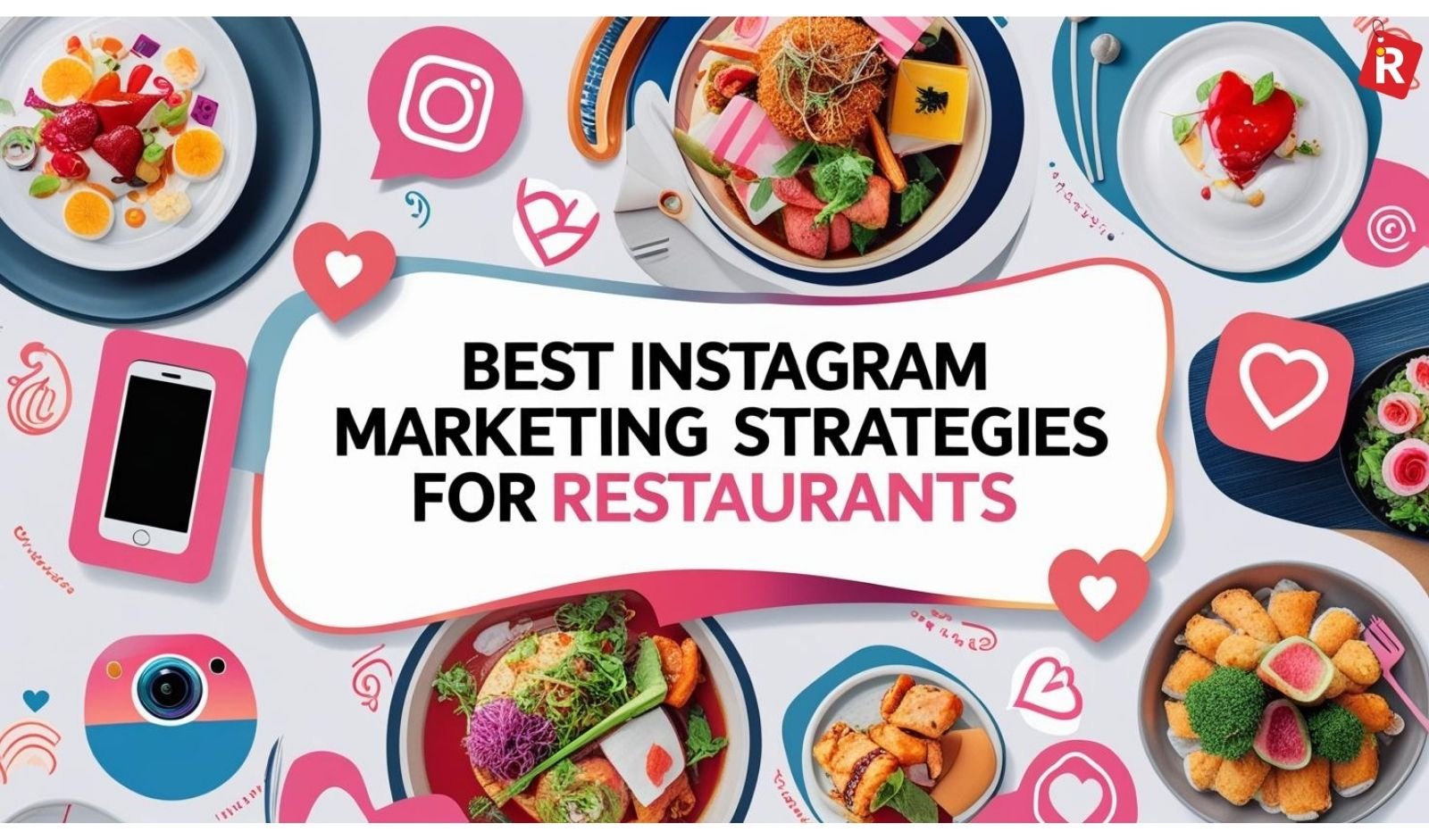
A restaurant’s digital presence is nearly as important in the visually driven digital age as the smells coming from its kitchen. Being active on social media means you can attract potential customers. And Instagram is the best medium for doing this. You can present mouthwatering food and create a lively community. Instagram has developed into a potent marketing tool that is more than just a photo-sharing app, particularly for the food and beverage sector.
Understanding Instagram marketing for restaurants in India and other countries involves more than just sharing eye-catching images; it also includes creating a calculated strategy that converts likes into repeat business and reservations. The top ten restaurant Instagram marketing techniques are described in this in-depth article to help your business expand rapidly and stand out in a congested industry.
1. Master the Art of High-Quality Food Photography and Videography
Instagram can show dishes that are a feast for the eyes, and your food should be the main attraction. Photos that are blurry and poorly lit are a common mistake. A significant difference can be achieved by investing in professional food photography, knowing the fundamentals of food styling, and utilizing natural lighting.
Pay Attention to Appetizing Visuals: Take note of your food’s distinctive plating, texture, steam, and vivid colors. When possible, use natural light, and make sure your backgrounds are simple and uncluttered so that the food is the main attraction.
Beyond the Plate: Don’t stop at merely completed meals. Display foaming coffees, freshly chopped ingredients, sizzling pans, or expertly made cocktails. These “process” photos have the potential to be really captivating.
The Key Is Consistency: Create a recognizable visual aesthetic that captures the essence of your company, whether it’s sleek and contemporary or rustic and homey. As a result, the stream becomes unified and identifiable.
For restaurants in India, where a variety of cuisines create a riot of colors and textures, having excellent visuals is essential to drawing in customers and emphasizing the genuineness of your goods.
What’s new: How to Brand your Restaurant?
2. Leverage Instagram Reels for Maximum Reach and Engagement
Reels are now the one Instagram feature that provides unmatched organic reach. Algorithms love short-form, lively videos, which can greatly increase your exposure to new viewers.
Behind-the-Scenes Magic: Display snippets of your kitchen as it works, a chef fervently creating a specialty dish, or the vibrant atmosphere during busy times. The “making of” their favorite cuisine is something that people adore.
New Menu Item Reveals: Use captivating, fast cuts and popular music to introduce new dishes. Create suspense and give the audience a preview.
Highlights of the Chef and Staff: Present your group! You can engage with your audience and personalize your company by creating brief, entertaining videos of your servers, chefs, or bartenders.
Food Challenges & Trends: Engage in popular audio challenges or design your own culinary challenges tailored to a particular restaurant to promote user involvement.
Quick Tutorials/Tips: Give a brief wine-food pairing hint or a quick recipe hack that draws inspiration from your cuisine.
Use Trending Audio: To make your reels more discoverable, include popular songs and sounds.
Optimize for Local Discovery: To show up in “Near You” suggestions, always include geo-tags and location stickers in your reels.
Reels often work best for restaurants from mid-morning to early afternoon (10 AM – 2 PM) and again in the evenings (7 PM – 9 PM) on weekdays, when customers are often planning their meals or unwinding.
3. Craft an Optimized and Engaging Instagram Profile
Your Instagram profile serves as your digital storefront. Make the most of your initial impression with potential customers.
Compelling Bio: A compelling bio should identify the type of restaurant you are, the cuisine you provide, and your unique selling point. Include relevant keywords (for example, “Best Italian Food in Your City” or “Vegan Cafe”).
Link in Bio: Make effective use of the link in your bio. Send customers to your online ordering platform, reservation page, website, or special campaign. Tools like Linktree can assist you in managing various links.
Contact Information: Ensure that your contact button functions properly, allowing users to phone, email, or get directions immediately.
Branded Highlights: Use Instagram Story Highlights to organize critical information such as your menu, daily offers, customer testimonials, behind-the-scenes content, events, and FAQs. Create unique, branded covers for these highlights to keep the look consistent.
Read new: How to Choose Restaurant’s Location?
4. Engage Actively with Your Audience
Instagram is more than just a means for broadcasting; it’s a social network. Building a devoted community and telling the algorithm that your material is valuable requires active engagement.
React Promptly: Give prompt, sincere responses to direct messages (DMs) and comments. Express gratitude to clients for their praise and properly handle their issues.
Pose Questions: In your captions, promote conversation by posing queries about dietary restrictions, favorite foods, or dining experiences.
Run Polls and Quizzes in Stories: To engage followers, collect preferences (e.g., “What’s your favorite spice level?”), and promote a sense of community, use interactive Story stickers.
Go Live: Conduct live cooking demonstrations, behind-the-scenes tours, or even Q&A sessions with your chef. This fosters genuineness and a closer bond.
5. Leverage User-Generated Content (UGC)
Your greatest marketers are your customers. It’s genuine, reliable, and extremely impactful when they post pictures or videos of their meal at your restaurant.
Promote Tagging: Put discreet signs on tables, menus, or in “Instagrammable” locations around your restaurant to invite customers to tag your account (@yourrestaurantname) and use your custom hashtag (#YourRestaurant).
Repost with Credit: Always get consent before reposting excellent user-generated content on your feed or Stories, making sure to tag the original creator. In addition to offering new information, this gives clients a sense of worth and inspires others to contribute.
Conduct Contests: Hold competitions where patrons can enter to win a meal or a discount by tagging your business in their finest food photos.
Know more: How to Survive in Reviving Restaurant Markets?
6. Collaborate with Local Food Influencers and Bloggers
Influencer marketing is revolutionary, particularly in the food sector. Popular local community pages, micro-influencers, or even local food bloggers can expose your restaurant to a large, relevant audience.
Find Relevant Influencers: Seek out people who have a devoted local following and whose content complements the brand of your business.
Provide Experiential Opportunities: Ask them to join you for a free lunch, a sample, or a first look at a new menu.
Set Clear Expectations: Clearly define your expectations by talking about the kind of content they will produce (posts, reels, and stories) and the main points you want them to make.
Emphasis on Authenticity: Influencers’ sincere enthusiasm and reviews have a greater impact than excessively promoted content.
7. Utilize Instagram Ads for Targeted Reach
Instagram’s powerful advertising platform enables highly targeted campaigns that can greatly increase your reach and encourage particular activities, even though organic reach is still crucial.
Targeting Options: Utilize Instagram Ads to connect with prospective clients based on demographics (gender, age), preferences (food, eating out, particular cuisines), and—most importantly—location (e.g., clients in the 5–10 km radius of your restaurant).
Campaign Goals: Specify your goal, such as increasing direct messages, website clicks (for online purchases or reservations), or profile visits.
Carousel ads: In a single ad, promote several dishes or other facets of your restaurant, such as the atmosphere, specialty cocktails, or dessert selection.
Retargeting: Retargeting is the practice of reminding people who have already interacted with your content or visited your website to become paying clients.
8. Run Engaging Contests and Giveaways
Contests are a great way to increase follower numbers, increase interaction, and create talk about your restaurant.
Define Clear Rules: Clearly outline the requirements for entry, such as liking the post, tagging friends, following your account, and sharing to Story.
Provide Interesting Rewards: Free meals, gift cards, special dining occasions, or small-group catering are all excellent sources of motivation.
Variety of Contests: Try “tag a friend” giveaways, caption contests, photo contests, or restaurant trivia.
Frequency: Avoid going overboard. Periodically hold competitions to keep things interesting without undervaluing your products.
Know this: How to Manage your Restaurants’ Brand Identity?
9. Optimize for Local SEO with Hashtags and Geotags
Local visibility is crucial for a business. Instagram provides easy-to-use yet powerful solutions to guarantee that you appear in local searches.
Location Tags: In every post and story, make sure to provide the actual address of your restaurant. Your content will show up when users look for local locations.
Local Hashtags: Use a combination of general and specific local hashtags. Examples: #FaridabadFoodies, #BestRestaurantsInFaridabad, #HaryanaEats, #IndianCuisineFaridabad, #WhatsCookingFaridabad.
Branded Hashtag: Make your restaurant’s hashtag distinctive and promote its usage.
Relevant Niche Hashtags: Use hashtags that are relevant to your food, ingredients, or dining experience. (e.g., #PaneerTikka, #VeganOptions, #FineDining, #CasualEats).
10. Maintain a Consistent Posting Schedule
Maintaining your audience’s attention and appeasing the Instagram algorithm depend on consistency.
Create a Content Calendar: Arrange your posts ahead of time, describing the week’s or month’s themes, recipes, and promotions. This guarantees a constant supply of new material.
Optimal Timing: Use Instagram Insights to find out when your particular audience is most active. In India, the ideal times for restaurants on Instagram are generally between 9 AM and 1 PM on weekdays (for lunchtime planning) and between 7 PM and 9 PM (for dinner planning/post-dinner scrolling). Try different things and make adjustments.
Use a Variety of Content Formats: Don’t only share pictures. To keep your feed interesting and dynamic, incorporate reels, stories, carousels, and occasionally live videos.
Quality over Quantity: Although regularity is crucial, never sacrifice the standard of your material in the name of frequency. Three average posts are not as good as one excellent one.
Check out: How to Win Restaurant Business during Slowdown
Your Restaurant’s Digital Growth Engine
Having a good Instagram presence is now essential to restaurant success in the cutthroat culinary scene of India or any other country. Your restaurant can turn its Instagram profile into a potent tool for drawing in new clients, cultivating devoted followings, and eventually generating substantial revenue growth by carefully implementing these ten tactics, which range from eye-catching images and dynamic reels to strategic partnerships and data-driven insights. Adopt these strategies, share your distinctive culinary tale, and see how your brand grows online.
Restaurants & Food
28 new restaurants in India you should grab a meal at this August – Vogue India
Restaurants & Food
The Taste by Vir Sanghvi: Indian restaurants shine globally with Michelin stars and authentic flavours
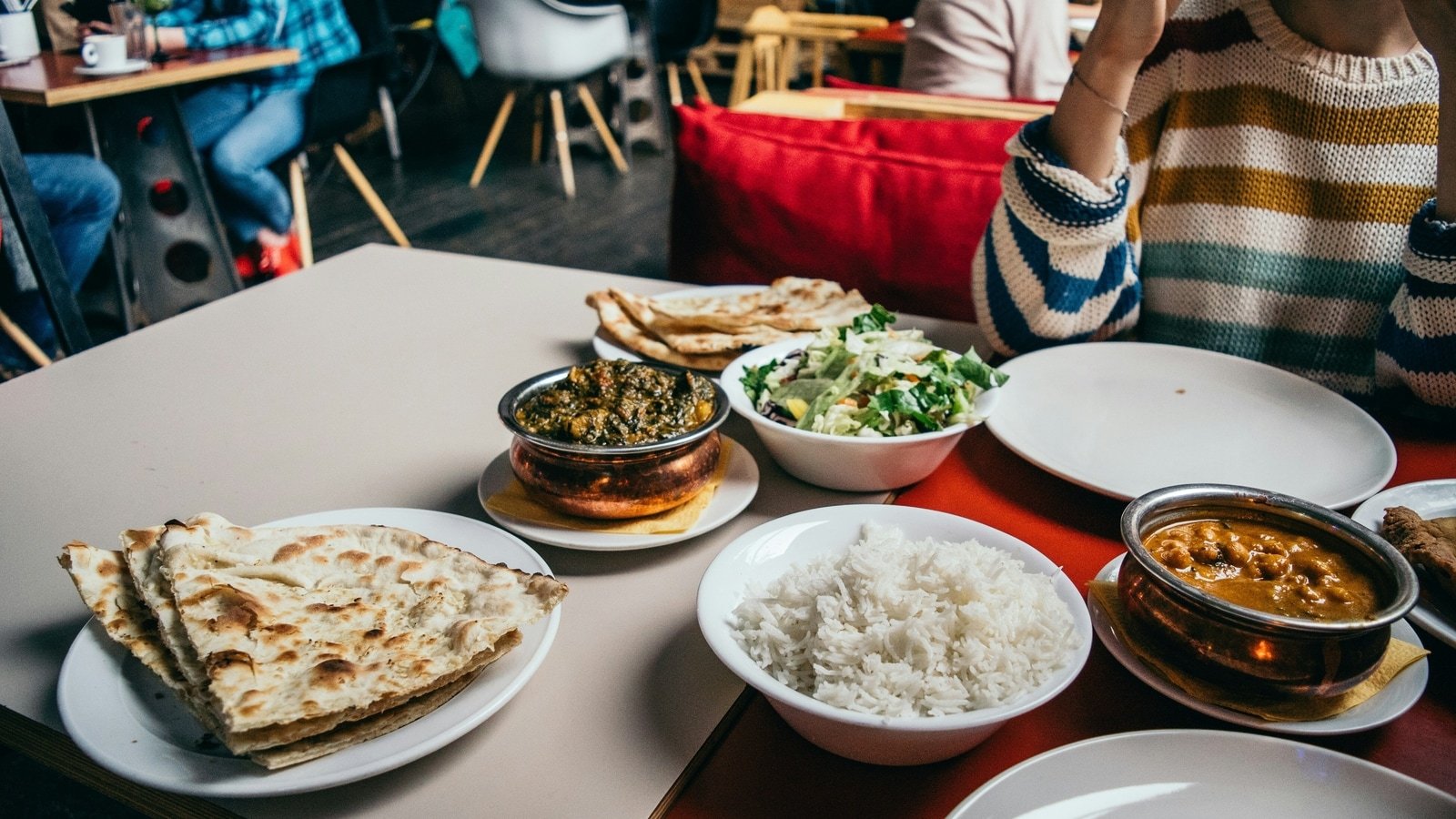
You have probably heard of Semma, the only Indian restaurant in New York to win a Michelin star. And of Gymkhana, the only Indian restaurant with two Michelin stars in London. Of Jamavar, the only Indian restaurant in the world to have won Michelin stars in three different avatars in three different cities: London, Doha and Dubai.
What, you may well ask, do these restaurants have in common?
There are two answers to this question. The first is the obvious one: they are all Indian restaurants run by chefs who have worked or trained in India. Vijaya Kumar of Semma is very proud of cooking the authentic cuisine of Tamil Nadu’s not-so-elevated castes and makes it hot and spicy. (He started out at the Taj Connemara in Chennai.) His boss, and one of the founders of Unapologetic Foods, which owns Semma, Chef Chintan Pandya, says that the group gets its name from its determination to refuse to apologise for the flavours and oil that characterise Indian food. (Chintan is ex-Oberoi.)
In London, one of the first things that Karam Sethi, the chef-founder of Gymkhana, said to me when I called to congratulate him on Gymkhana’s two stars was “it’s real Indian food, not ‘modern’ Indian.” Gymkhana serves the sort of food Indians actually eat, not a poncy, spice-deprived version. Gymkhana’s Executive Chef Sid Ahuja is ex-Oberoi and Sethi himself trained with ITC.
The most recognisable Indian of the top global restaurants is Jamavar. It was founded by Dinesh Nair, whose family used to own Leela Hotels, and is run by his whiz-kid daughter, Samyukta. The London Jamavar is international in clientele but you will nearly always see a top Indian movie star or cricketer there. This may have something to do with the fact that its chef, Surender Mohan, commands after his years working with the Leela group in India.
Samyukta and Surender took Jamavar to Doha where it became just one of two restaurants to win a Michelin star. (The other restaurant with a star is run by Alain Ducasse.) Next, they opened in Dubai and within a few months of opening, they had a star there too.
I met Surender at the Michelin ceremony in Dubai and was pleased to see that he was one of the few chefs not to be intimidated by the occasion and he gave the longest and best speech of the evening. But then I guess he is now used to attending these events in city after city.
Clearly something new and unusual is happening with Indian food abroad even if we don’t fully understand it here in India. There have been, broadly, four phases with Indian food in the West. The first was the ‘ethnic food’ phase when Indian food became the browner equivalent of chop suey and restaurants served mostly made-up Indian dishes at inexpensive prices.
The second was when Indian food went upmarket but was also Frenchified and plated. In the UK, restaurants serving this kind of food were celebrated and some got Michelin stars. In New York, Floyd Cardoz served two kinds of cuisine. At Tabla, he served a nouvelle take on Indian food and got three stars from the New York Times. But downstairs, at the Bread Bar, the food was more basic and less nouvelle. Even so, the general rule was that if you wanted rave reviews and high-profile rich guests, then you moved away from traditional Indian.
The third phase coincided with a global change in food preferences when French food ceased to be as admired as much. As El Bulli and later, Noma, set the trend, this was reflected in Indian food too. Gaggan Anand worked with the Adria brothers of El Bulli and opened a restaurant in Bangkok that served the kind of Indian food nobody had imagined could exist. Also, in Bangkok, Garima Arora opened Gaa which went on to win two Michelin stars. There was a fair amount of cross-fertilisation. Garima had worked with Rene Redzepi at Noma and with Gaggan. Redzepi himself had worked at El Bulli.
Almost simultaneously, Manish Mehrotra, whose resume included no great restaurants, invented his own version of modern Indian cuisine at Delhi’s Indian Accent. Mehrotra’s background was oriental cuisine so he had no interest in Frenchifying his food. Mehrotra and Gaggan ended up being the most influential Indian chefs of this century with their dishes being copied all over the world.
Himanshu Saini, the only Indian chef with a restaurant that has three Michelin stars (Dubai’s Tresind Studio) worked with Manish and is candid about his debt to the master.
But now I think we are into a third phase. People want Indian food without the frills. They want to eat like Indians eat in India. Vikas Khanna, India’s most famous chef, opened Bungalow in New York, serving food that was no different to the food he would serve in India and got three stars from the New York Times, and there’s usually a queue for tables outside his restaurant. At the less expensive end of the market Dhishoom which claims to be inspired by Mumbai’s Irani restaurants is so successful across the UK that it has now set its sights on America.
Of course, no change is absolute. There are still Bangladeshi curry houses calling themselves Indian restaurants. The Frenchified expensive Indian restaurants survive. The Gaggan-style modern Indian is still a rage.
But the trend is clear: Keep it simple and keep it spicy.
Restaurants & Food
Food Picks: Modern Indian with a Western twist at Firangi Superstar
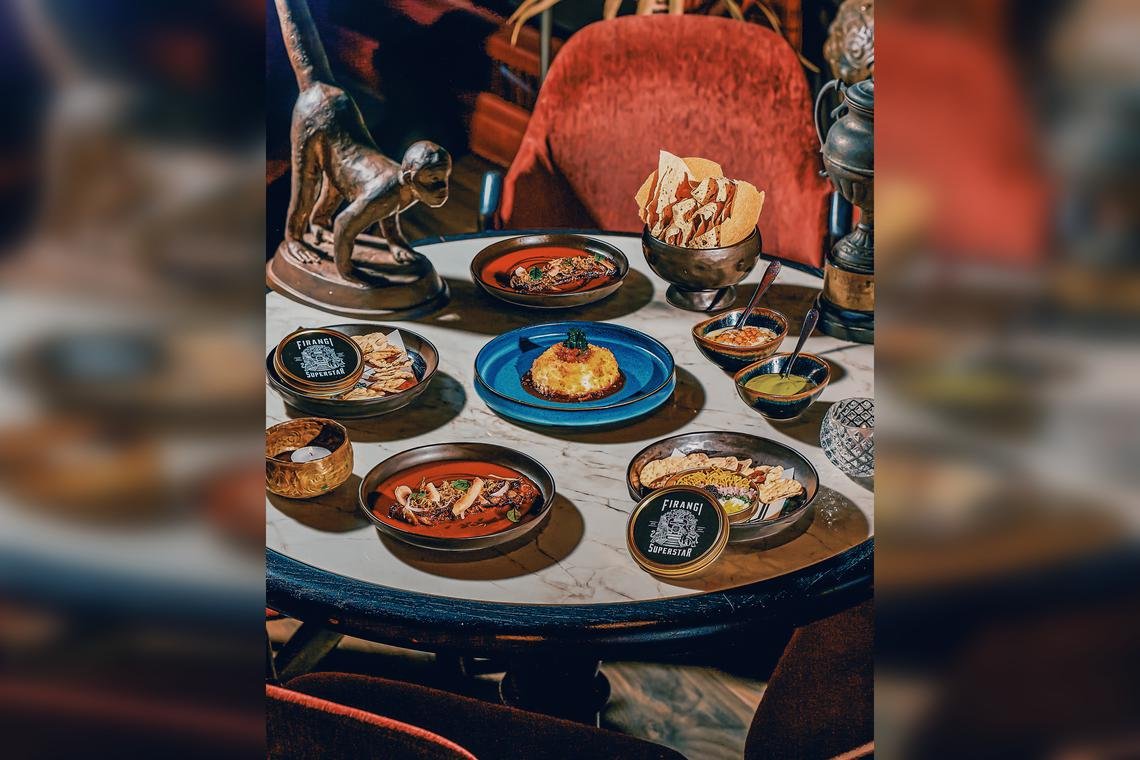
SINGAPORE – Do not be fooled by Firangi Superstar’s plain terracotta exterior. There is nothing minimalist about the experience here.
It overwhelms before the first bite even hits the table, spinning you through rooms crammed with memorabilia. Think American film-maker Wes Anderson on a trip through Delhi, a kind of kitschy fantasyland for colonial nostalgists wrapped in ornate wallpaper and studded with vintage firearms.
Thankfully, this meeting of worlds is far more amicable when confined to the kitchen of this modern Indian restaurant, which opened in 2021.
Firangi Superstar’s decor is as bold as its menu.
PHOTO: FIRANGI SUPERSTAR
Have a seat. Red? Blue? Cushion? Chair? Oh, here comes the menu, recently revamped and folded into a newspaper – with actual clippings, by the way, just in case you were done gawking at the mounted moose heads on the wall and wanted something else to look at.
Open it up. Today’s big story is a list of dishes, both old and new, Indian and international, all with characteristically eyebrow-waggling names.
Some riff off old iterations – This Is Also Not Aloo Gobi ($18++) still holds the traditional curry at arm’s length, even as it borrows its taste. Others squeeze in a winky pun – We’re Goan-Ing To Porto! ($96) beckons to diners with grilled Iberico pork and sorpotel chilli sauce.
Big personalities work only if backed up with big flavours, and Firangi Superstar’s bite is as good as its bark. Starters like Papi’s Jammed Gun ($29++), wagyu beef tartare with caviar, grated egg and gunpowder spice, and Big Baller Peperoner ($28++), its version of paneer Manchurian, with fried burrata and Manchurian chilli sauce, expertly fuse Western ideas with south Asian flair.
The Bengal Bake-Off from Firangi Superstar.
PHOTO: FIRANGI SUPERSTAR
Off to a riotous start, I move on to mains. The Bengal Bake-Off ($108++) is trotted out in show-stopping fashion: a salt-baked seabass emerges from its crust, tender and steaming, and is robed in Kasundi cream.
Back In The Saddle ($21++ for 100g) triumphantly rides in on tandoori-spiced lamb, crowned with confit garlic and chilli leaf. All these dishes also come in vegetarian form, should you so desire.
In the middle of this lip-smacking extravagance, a few humble sides quietly sneak their way onto the table. Turn your attention immediately to the black garlic naan ($14++). Look how pillowy the bread is, breathe in its nutty fragrance. You already know it is going to be a knockout.
End the night with some banoffee fritters ($14++) or Rasmalai “tres leches” ($16++). Recline back on your throne of pillows, cocktail or royal melon lassi ($20++) in hand.
Firangi – Hindi slang for foreigner – or no, one really does feel like a superstar here.
Where: 01-03, 20 Craig Road
MRT: Maxwell/Tanjong Pagar
Open: Noon to 2.30pm, 5.30 to 10pm (Mondays to Saturdays)
Info:
www.firangisuperstar.com
-

 Brand Stories2 weeks ago
Brand Stories2 weeks agoBloom Hotels: A Modern Vision of Hospitality Redefining Travel
-

 Brand Stories2 weeks ago
Brand Stories2 weeks agoCheQin.ai sets a new standard for hotel booking with its AI capabilities: empowering travellers to bargain, choose the best, and book with clarity.
-

 Destinations & Things To Do3 weeks ago
Destinations & Things To Do3 weeks agoUntouched Destinations: Stunning Hidden Gems You Must Visit
-

 Destinations & Things To Do2 weeks ago
Destinations & Things To Do2 weeks agoThis Hidden Beach in India Glows at Night-But Only in One Secret Season
-

 AI in Travel3 weeks ago
AI in Travel3 weeks agoAI Travel Revolution: Must-Have Guide to the Best Experience
-

 Brand Stories1 month ago
Brand Stories1 month agoVoice AI Startup ElevenLabs Plans to Add Hubs Around the World
-

 Brand Stories4 weeks ago
Brand Stories4 weeks agoHow Elon Musk’s rogue Grok chatbot became a cautionary AI tale
-

 Brand Stories2 weeks ago
Brand Stories2 weeks agoContactless Hospitality: Why Remote Management Technology Is Key to Seamless Guest Experiences
-

 Asia Travel Pulse1 month ago
Asia Travel Pulse1 month agoLooking For Adventure In Asia? Here Are 7 Epic Destinations You Need To Experience At Least Once – Zee News
-

 AI in Travel1 month ago
AI in Travel1 month ago‘Will AI take my job?’ A trip to a Beijing fortune-telling bar to see what lies ahead | China



